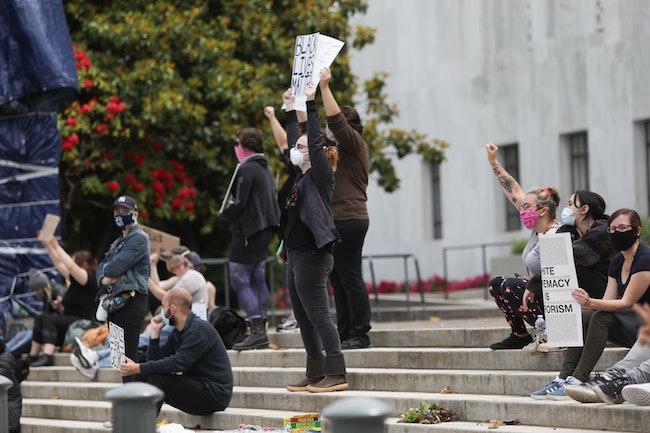
Demonstrators gather outside the state Capitol on Sunday, May 31, to protest police violence. The protests in Salem were among those that occurred across the country in response to the death of George Floyd, a Minneapolis man who died while being taken into custody by police. (Amanda Loman/Salem Reporter)
Fellow protesters are at fault for injuring a Salem woman who suffered permanent vision loss following a racial justice protest last summer, lawyers for the city of Salem said in court filing Friday.
Eleaqia McCrae filed a federal lawsuit against the city last August alleging she was shot by Salem police officer Robert Johnston with a rubber bullet and sustained eye damage. In the city’s response Friday, attorneys Gerald Warren and Jennifer Gaddis said the lawsuit should be dismissed because it was protesters who threw an object at her, not police.
“All claims should be dismissed against all defendants because plaintiff was in a group that was engaged in a violent, unlawful protest when she was struck with an object thrown by another protester who was apparently attempting to assault police officers,” the motion for summary judgement reads.
DOCUMENT LINK: Motion for summary judgement
The initial complaint sought to change Salem Police Department policies and practices, including the use of less lethal munitions, following racial justice protests that occurred in Salem in late May and early June. Mayor Chuck Bennett, City Manager Steve Powers, former Police Chief Jerry Moore, officers Kevin Ramirez and Robert Johnston are all named in the lawsuit.
Kevin Brague, McCrae’s attorney, wouldn’t comment on the city’s response when reached Wednesday. He said he plans to file a response within the next month.
The new filing provides additional insight into the May 31 night from the city’s perspective, with details from police officer accounts, McCrae’s testimony and video footage.
Friday’s court filing offers the following account of what happened on May 31, as Salem and other cities across the country protested police violence following the murder of George Floyd.
McCrae, McCrae a West Salem High School graduate and student-athlete at Mt. Hood Community College, learned about the protest after seeing her friend post about it on Instagram and arrived at the peaceful protest with her sister and a friend around 7:30 p.m., the motion said.
The group of demonstrators marched to the Center Street Bridge, blocking the bridge, and walked and back to the Oregon State Capitol around 9 p.m., the motion said.
Police said blocking the bridge created a public safety hazard, so they sent out the mobile response team, a group of officers trained in crowd control.
While back at the Capitol, demonstrators laid down in the street, the motion said.
At 9:52 p.m. Lt. Jason Van Meter declared an unlawful assembly and ordered demonstrators to disperse “after observing the crowd and threat to public safety” when protesters threw objects at police, the motion said.
More than a dozen police officers testified that protesters threw rocks, bricks, lit fireworks, glass bottles, full plastic water bottles, and water bottles with nails inside of them at them.
One officer felt firework sparks go through the back of his pant leg, another suffered ringing in his ears for 12 hours and a third was hit and bruised by a baseball-sized rock, according to the motion.
The motion said McCrae testified, “People on the outsides of the crowd started throwing water bottles, but before this it was very peaceful.”
Six minutes after declaring the unlawful assembly, police used tear gas and other “less lethal munitions” on the crowd. That was the first weekend the Salem Police Department had used tear gas on a crowd in its history, Moore said in a briefing following the protests.
Johnston was one of three officers using “less lethal munitions” that night. He carried blunt impact projectile rounds, stinger rounds and gas rounds, the court filing said.
A 60-caliber Stinger round is a 4.8-inch casing that contains about 18 rubber balls and can travel at a speed of 325 feet per second, or 221 mph. The motion said projectiles are meant to be fired low “to strike the crowd in the shins with small rubber balls.”
“Essentially, Stinger rounds are a form of pain compliance, used for routing crowds that are actively resistive,” the motion states.
Johnston said he shot stinger rounds at the ground on May 31, 2020, according to the filing.
The filing said, “At one point, plaintiff was struck by some object but is certain ‘it didn’t come from below.’”
The court filing quotes McCrae saying, “I remember turning around to leave but I can’t find (my sister). And in the moment, that’s when I said, oh, no, where’s (my sister), is when something hit me in the eye and it just went black.”
McCrae’s complaint in June said when she got up to leave, she was shot by police twice. One rubber bullet hit her chest and the other hit her eye. After being shot in the eye, McCrae bent over in pain and passed out, her complaint stated.
The city’s filing disputes that account, saying Sgt. Trevor Morrison saw McCrae get hit in the head with an object thrown from the crowd and documented it in an incident report on June 5, 2020.
The motion didn’t specify what kind of object hit her and said video footage from the night wasn’t clear enough to distinguish.
McCrae was taken to the emergency room for her eye injury and suffered permanent vision loss that requires surgery, according to the amended complaint filed by Brague in June.
The Friday motion from the city’s lawyers said Salem police didn’t receive any reports of injuries from less-lethal munitions other than from McCrae.
When responding to the amended complaint in June, the city argued McCrae’s injuries “if any” were caused by her own negligent conduct “by failing to disperse the area when the protests were no longer peaceful.”
Contact reporter Saphara Harrell at 503-549-6250, [email protected].
JUST THE FACTS, FOR SALEM – We report on your community with care and depth, fairness and accuracy. Get local news that matters to you. Subscribe to Salem Reporter starting at $5 a month. Click I want to subscribe!




